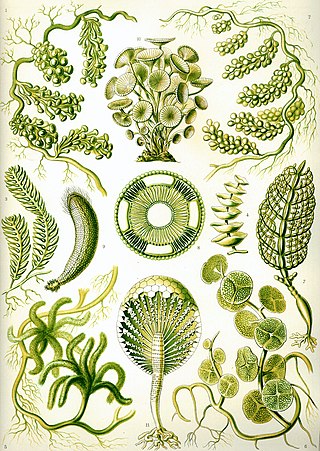
Chlorophyta is a division of green algae informally called chlorophytes.

The Trebouxiophyceae, also known as trebouxiophytes, are a class of green algae, in the division Chlorophyta. Members of this class are single-celled, colonial, or multicellular and are found in freshwater or terrestrial habitats worldwide. Many taxa in the Trebouxiophyceae form symbiotic relationships with other organisms; in particular, the majority of phycobionts within lichens are trebouxiophytes.

Microthamniaceae is a family of green algae in the class Trebouxiophyceae. It is the only family in the order Microthamniales.
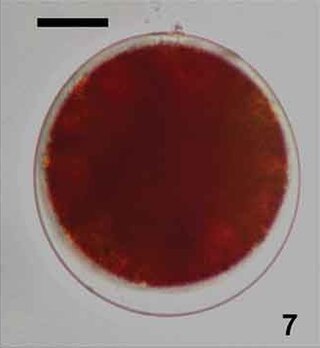
Chlainomonas is a genus of algae in the family Chlamydomonadaceae. They are found in freshwater habitats or on snow, where they are one of the main algae responsible for causing watermelon snow.
Dictyochloris is a genus of green algae in the class Chlorophyceae. It is the sole genus of the family Dictyochloridaceae. It is commonly found in terrestrial and subaerial habitats.
Dictyochloropsis is a genus of unicellular green alga of the phylum Chlorophyta. This genus consists of free-living algae which have a reticulate (net-like) chloroplast that varies slightly in morphology between species, and that when mature always lacks a pyrenoid. Dictyochloropsis is asexual and reproduces using autospores.
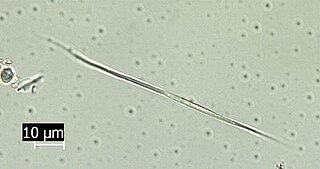
Koliella is a genus of green algae in the order Prasiolales. Members of this genus are found in freshwater plankton, but some are also found on snow and ice.

Lagerheimia is a genus of green algae in the family Oocystaceae. It is commonly found in freshwater habitats all over the world, although some species are rare and have only been recorded from Europe or the United States.
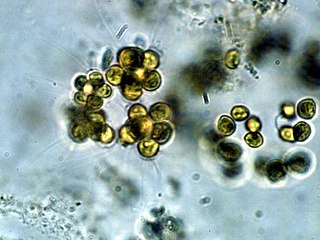
Micractinium is a genus of green algae in the family Chlorellaceae. Species of the genus Micractinium are common in freshwater habitats. A few species are found as endosymbionts of protozoa, such as Micractinium conductrix and Micractinium tetrahymenae.

Microthamnion is a genus of green algae in the family Microthamniaceae. It is found in freshwater habitats around the world, preferably with low levels of pollution; it is typically attached to solid substrates.

Radiofilum is a genus of green algae in the class Chlorophyceae. It is a freshwater genus; they are often found in soft, boggy or acidic waters.

Selenastrum is a genus of green algae in the family Selenastraceae. It is common in freshwater habitats around the world. Most species prefer temperate or warm-temperate waters.

Sorastrum is a genus of green algae in the family Hydrodictyaceae. It is a component of the phytoplankton of freshwater ponds, lakes, and ditches. Sorastrum is common in tropical to temperate regions of the world, but due to its small size it is often overlooked.

Trebouxia is a unicellular green alga. It is a photosynthetic organism that can exist in almost all habitats found in polar, tropical, and temperate regions. It can either exist in a symbiotic relationship with fungi in the form of lichen or it can survive independently as a free-living organism alone or in colonies. Trebouxia is the most common photobiont in extant lichens. It is a primary producer of marine, freshwater and terrestrial ecosystems. It uses carotenoids and chlorophyll a and b to harvest energy from the sun and provide nutrients to various animals and insects.
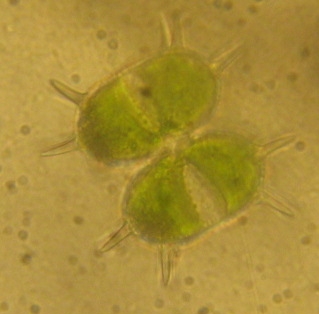
Xanthidium is a genus of green algae, specifically of the Desmidiaceae.

Crucigenia is a genus of green algae in the class Trebouxiophyceae. It is widespread, but not often abundant, in freshwater habitats around the world.
Symbiochloris reticulata is a species of green alga in the Trebouxiales. It is a known as a photobiont with several lichen species, like Lobaria pulmonaria, but also as a free-living soil alga as well. Phylogenetic analysis of rRNA sequence data revealed that the species shares a sister group relationship with two other green algae that lack motile stages, Chlorella saccharophila and C. luteoviridis.

The Klebsormidiaceae are a family containing five genera of charophyte green alga forming multicellular, non-branching filaments. The genus Chlorokybus was previously included as well, but this problematic and poorly known genus is now placed in a separate class Chlorokybophyceae.
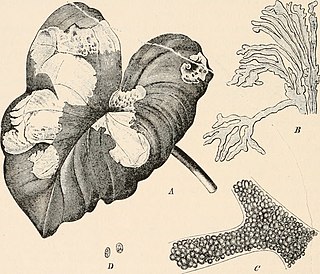
Phyllosiphon is a genus of green algae in the class Trebouxiophyceae. Unusually among the green algae, members of Phyllosiphon are often parasitic within the leaves of Araceae, causing necrosis. It has a mostly tropical to subtropical distribution, and is found primarily in the Mediterranean region, but has also been isolated in North America, Australia, Africa, and China.

Koliellaceae is a family of green algae in the order Prasiolales.















